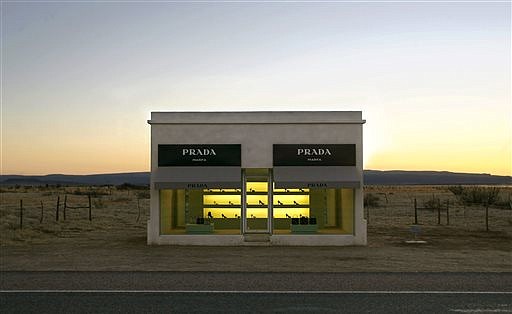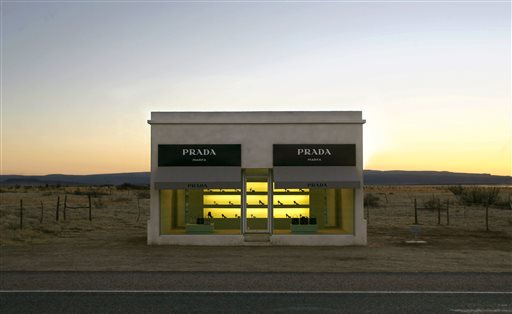EL PASO, Texas - The artists behind a sealed model Prada showroom that has stood for years along a West Texas desert highway said they are surprised that state officials recently deemed it a form of unlicensed advertising.
Michael Elmgreen and Ingar Dragset said in a Friday posting on Ballroom Marfa's website that they conceived of the Prada Marfa installation and that the work was realized in 2005 through a collaboration with Ballroom Marfa and another non-for-profit cultural organization, Art Production Fund and Ballroom Marfa.
"It was not a work commissioned by the fashion brand Prada nor had the fashion brand any involvement in the creation of this work," the artists said. They said Prada gave them permission to use its logo when they asked for it, and founder Miuccia Prada donated the shoes and bags that have remained on display in the shack-sized building to this day. Viewers can peer into the showroom from outside, but can't enter it.
For eight years, it has been a site of pilgrimage for art lovers, a surprise for travelers and a target for bored vandals.
"The right definition of advertisement must be based on criteria more accurate than just including any sign which contains a logo," they said.
The Texas Department of Transportation recently deemed the installation to be a form of advertising akin to a billboard. As such, it would need to be licensed by the state, but the area where it is located isn't eligible for such permits. The faux store is in Valentine, a community not far from the Mexican border and about 35 miles northwest of Marfa, the artsy town from which it gets its name.
The ruling follows a July ruling by the agency that declared another work along the same highway, the Playboy Marfa installation, to be an advertisement. The Playboy Marfa, which features a jet-black muscle car and a 40-foot-tall post with a neon-lit Playboy bunny on top, was designed by New York artist Richard Phillips and Playboy's creative director, Neville Wakefield.
After a Marfa resident filed a complaint about the Playboy sign, the state Department of Transportation issued a removal notice to Playboy but then gave the company a 60-day extension to allow them to find a solution.
"It is advertisement only when a company commissions someone to make such a sign, pays for its execution or makes a sign themselves in order to promote the company's products," the artists said. "Prada Marfa never had any commercial link to the fashion brand Prada, unlike the Playboy bunny which went up this summer initiated by Playboy itself."
When it issued its ruling, the agency said it hadn't decided what to do about the installation. It didn't respond to an email seeking comment Saturday.

